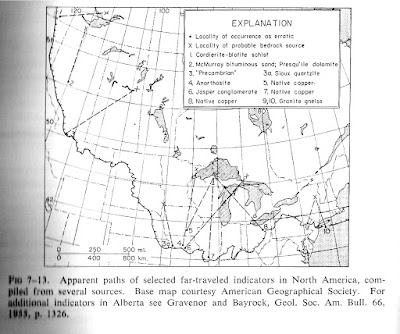Super-erratic from Scandinavia, now found on the coast of Estonia. Weight -- approx 2,500 tonnes.
The Thunder Stone is a vast erratic of Rapakivi Granite used as the plinth for a famous statue of Peter the Great in St Petersburg. It was found in marshy ground not far from the shore of the Gulf of Finland, and was moved to its designated place entirely by "people power" over the course of two years. It was reputed to weigh 1500 tonnes. This granite outcrops in a number of places in southern Finland. (Thanks to Tony for bringing this to my attention.)
On this map from RF Flint (1957) the Rapakivi granite outcrops are numbered 3 and 5. The "Thunder Stone" was picked up maybe 60-70 km from its source, having been transported by ice in a SE direction.
Here are some maps of erratic trains and fans from around the world. Widely differing scales. Note that erratic trails or trains are relatively thin but are simplified on maps by drawing a line between source and end destination. This is misleading, since erratic travel is normally NOT direct, since ice movement directions are shifting all the time. More realistically, a zig-zag movement should be portrayed. The maps showing "indicator fans" are also unrealistic, since they simply show the widest possible dispersal of rocks picked up by a glacier from a singe provenance or source. This to some degree demonstrates shifting ice movement directions. Another factor to be taken into account is that many erratic boulders have been moved incrementally over the course of several different glaciations.
Note that some erratic blocks in Scandinavia and North America have been moved over 1,000 km. That having been said, the great majority of erratic boulders (and "super-erratics") are derived from locations less than 10 km away from the places where they are now found.
Fracture opening up on Rödlöga Storskär in the Stockholm Archipelago. Probably this coincides with a pre-existing joint in the bedrock. If the Last Glaciation had gone on for a little longer, a giant erratic weighing 100,000 tonnes would have been dragged away southwards.








1 comment:
Does Mike Parker Pearson know about the Thunder Stone's movement by serfs in Russia? Surely he is able to make a massive ethnographic ASSUMPTION out of this? Watch his space, or that of the UCL Institute of Archaeology, and be afraid, very afraid......
Post a Comment